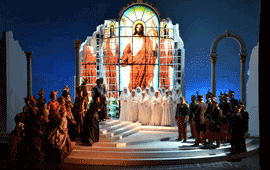> [Archived] Chronicles

A Large-scale Event at the Timișoara Opera House
By transferring the action to the 19th century, the age when Verdi lived, Corneliu Murgu's direction proposes a fast-paced action, whose flow is ensured by using the revolving stage, which helps move from one scene to another; it is a space where characters are sketched naturally, with strong relationships. This new concept also brings a few novelties, such as the famous Gypsy choir singing backstage at first, with the choir members slowly entering the stage, creating a unique effect, like the flame-ballerinas dancing around Azucena, suggesting the obsessive pyre, and in the final scene, Leonora remains outside the prison where Manrico is locked up, the bars separating them in that lyrical-dramatic moment. Another important aspect is that the choir members did not sing facing the conductor anymore, but rather took the attitudes required by the action, sometimes even with their backs at the audience, which highlights the credibility of the moment.
That evening, the personality of the guests left an imprint on the way the heroes were portrayed, taking something from previous performances on the world's greatest stages, so that future ones will definitely show certain differences in approaching the roles; the director's intention - with his own experience as a soloist, thus looking at it 'from within' - is to leave interpreters their freedom of movement, without imposing rigid requirements that find no place in a contemporary staging. To this end, he wanted to show a vision with a touch of modernity, while keeping the traditional coordinates required by the music and the libretto, choosing functional, stylised scenery; created by architect Cătălin Ionescu-Arbore (who made the entire scenography), this has a fixed structure, with varied elements that give the atmosphere of every scene, and it only includes a few steps, battlements, a white wall with a kind of mirror 'split' in dozens of little surfaces meant to reflect light, then thin gilded columns, together with arcades, a huge stained glass icon, drapery, a metallic grate etc. The costumes are representative, often elegant, mingling shiny uniforms with trimmings and trousers that are (too) bright red, sumptuous court gowns and multicoloured Gypsy dresses, with gold coin necklaces and other specific details (which make the scene truly charming). I have to admit I had my reserves about the concept of the lights, much too bright and 'white' either in the middle of the night or in the church or prison, where everything needed to be in dim lights, enhancing the mystery, the drama or the atmosphere of prayer, all these aspects being 'atomised' by the excessive light.
But opera means music, and from this point of view it was splendid, because Marianne Cornetti was a gushing Azucena, with a strong voice shrouded in colour or bursting beyond belief, with a temperament and a force that she adapted perfectly to the character, because George Petean had a generous voice, with Verdian phrasing and accents, but most importantly, with an expressive sense of involvement highlighted much more strongly than in his usual performances, because Dragana Radakoviæ was charming thanks to the quality of her singing and her adequate stage presence. Leonardo Gramegna was an honest Manrico, self-assured after a rather insecure beginning, and surprised us by the staccato rhythm of the 'serenade' that seemed almost too military, Octavian Vlaicu sang the role of Ferrando in his usual manner, Crina Vezentan made Ines seem Leonora's friend rather than her maidservant, which I find logical enough; Remus Alăzăroae (Ruiz) and Iulian Iosip (The old Gypsy) completed the well-balanced cast, the choir (supervised by Laura Mare) sounded excellent, with well-dosed intensity and expressive nuances, and the orchestra proved once again that it is a quality ensemble; conducted firmly and dynamically by David Crescenzi, they managed to give a supple performance, with unique colours, supporting the soloists in the interpretive attempts, in an artistic approach where lyricism and dramatism abounded. The enthusiastic audience applauded all of them at the end; even the most critical spectators had to admit everyone involved in the musical performance was of world-class level.
The new staging of Il Trovatore marked not only the wonderful debut of Corneliu Murgu as a director, but also the novelty of a different vision on the stage of Timișoara, a modern, airy one, with an international cast; inviting two of the interpreters from the first production, 55 years ago, was a truly elegant idea. The manager of the theatre explained, to the delight of the audience, that, back then, the conductor was Ladislau Rooth and mezzosoprano Mira Popescu sang the role of Azucena. Otherwise, the performance that ended the festival represented an emotional, nostalgic bridge across time, as well as a new landmark in the rich repertoire of the Timișoara Opera House, which keeps offering unforgettable evenings. The fact that the closing night's performance was sold out, with guests from Germany, Bucharest or Cluj, goes to prove its truly remarkable character.
Translated by Irina Borțoi and Elena Daniela Radu
MTTLC, The University of Bucharest














